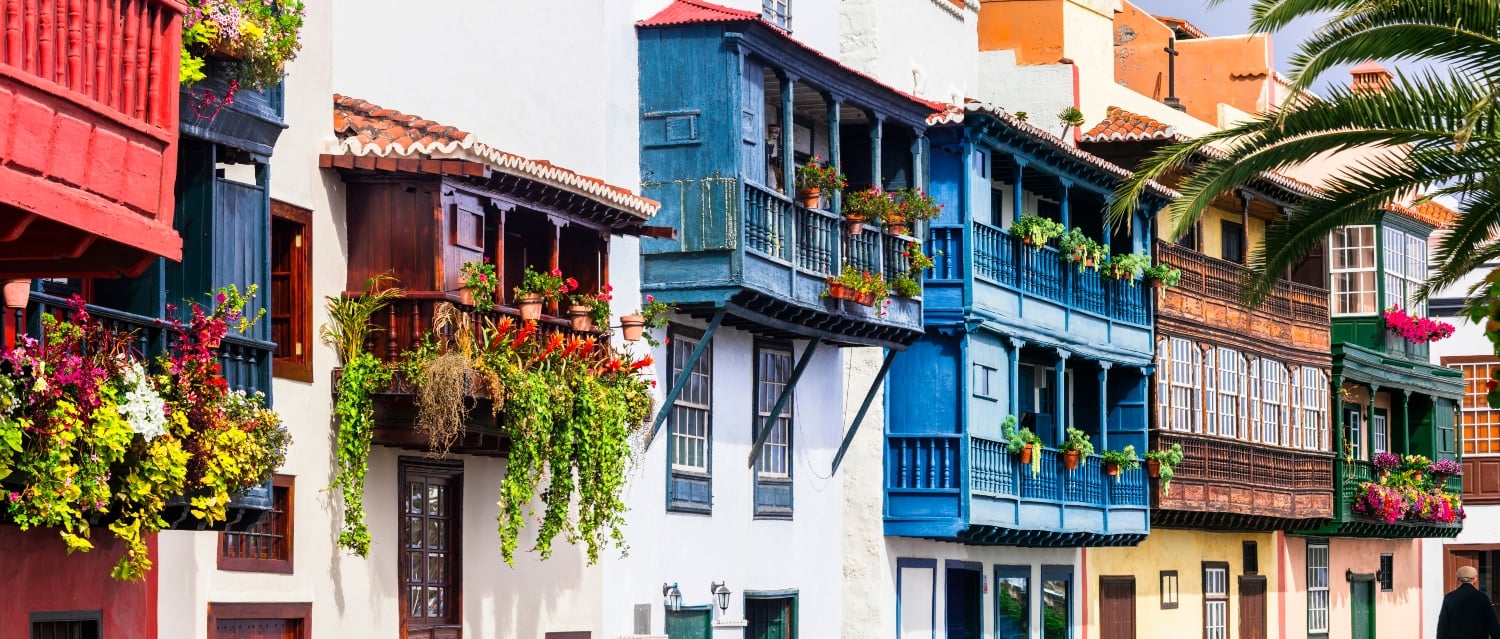With year-round sunshine, diverse landscapes and short flights from the UK, the Canary Islands are a top choice for overseas buyers. In this guide, we explore the highlights of each island, outline what makes the Canaries such a reliable investment and walk you through the steps to owning a home there.
The Canary Islands are more than just a winter escape. They’re a unique part of Spain, with their own identity, climate and pace of life. Whether you’re dreaming of volcanic views in Lanzarote or whiling away the hours on a golf-course in Tenerife, here’s your complete guide to buying a property in the Canaries.
Download the Spain Buying Guide
Contents
Why buy property in the Canary Islands?
The Canary Islands, located off the north-west coast of Africa, are part of Spain but have a distinctive character all their own. With pleasant weather all year, varied scenery and strong infrastructure, they’re a popular choice for lifestyle seekers, retirees and holiday home buyers. Their location – just a four-hour flight from the UK – means you can swap drizzle for sea views in a single morning.
There are seven main islands: Tenerife, Gran Canaria, Lanzarote, Fuerteventura, La Palma, La Gomera and El Hierro. Each offers its own pace of life, property styles and investment potential.
Climate and lifestyle
The Canary Islands are often dubbed the “Islands of Eternal Spring”, and you can understand why. Average temperatures range from 18°C in winter to 25°C in summer. Rain is rare, and the Atlantic breeze keeps things fresh even during warmer months. Unlike many Mediterranean destinations, the Canaries never really shut down – making them ideal for year-round living or holiday lets.
Outdoor living is the norm, with water sports, golf, hiking and al fresco dining part of daily life. It’s a lifestyle that appeals to retirees, remote workers and holidaymakers alike.
Where to buy: highlights of each island
Each island has its own charm – and a different type of buyer it appeals to. Here’s what you need to know.
Tenerife: the all-rounder
Tenerife is the largest island and has the broadest appeal. Its southern coast – including areas like Costa Adeje, Los Cristianos and Las Américas – is the most popular with overseas buyers. Expect a lively expat community, Blue Flag beaches and plenty of golf and nightlife.
The north offers a more traditional Spanish feel, especially in towns like Puerto de la Cruz and La Orotava. You’ll also find green valleys and banana plantations thanks to the cooler, wetter microclimate.
Property prices are highest in the south but vary greatly inland. Tenerife has two international airports, excellent healthcare and one of Spain’s biggest carnivals, the Carnival of Santa Cruz de Tenerife.
Gran Canaria: big city and beach life
Gran Canaria is known for its variety – from white sand dunes and hidden valleys to the cosmopolitan capital, Las Palmas. Buyers who want both a beach apartment and a proper city experience often choose here.
Popular areas include Maspalomas, Playa del Inglés and Puerto de Mogán – often nicknamed “Little Venice” for its canals and charming marina. Inland, you’ll find villages with traditional stone houses and hiking trails.
Lanzarote: sustainable and sculpted
Lanzarote is famous for its otherworldly volcanic terrain and unique architecture, much of it shaped by artist César Manrique. Development is strictly controlled – buildings are whitewashed and low-rise by law, which adds to the island’s quiet charm.
Puerto del Carmen, Playa Blanca and Costa Teguise are the main hubs. In the north, villages like Haria and Teguise offer peace, nature and more budget-friendly properties. The wine-growing region around La Geria is a must-see – grapes are grown in volcanic pits and protected by rock walls.
Fuerteventura: beach-lover’s paradise
If sandy beaches and surfing are your priority, Fuerteventura could be your spot. The island is less built up than Tenerife or Gran Canaria, but increasingly popular with digital nomads and second-home owners.
Corralejo in the north is the most vibrant town, while Caleta de Fuste and Costa Calma are popular resort areas. Inland, there are affordable village homes with strong rental potential.
La Palma, La Gomera and El Hierro: quiet escapes
These smaller islands attract nature lovers and off-grid buyers. Think hiking trails, coffee plantations and starry skies rather than tourist resorts. Properties here tend to be rural fincas or traditional houses in need of renovation – ideal for buyers seeking a more traditional, slower pace of life.
Search homes for sale in Spain
Property prices and investment potential
The Canary Islands offer better value for money than mainland hotspots like Marbella or Mallorca – but demand is growing, especially post-pandemic.
| Island | Popular areas | Average apartment price |
|---|---|---|
| Tenerife | Costa Adeje, Los Cristianos | €200,000-€350,000 |
| Lanzarote | Puerto del Carmen, Playa Blanca | €180,000-€300,000 |
| Gran Canaria | Las Palmas, Maspalomas | €180,000-€350,000 |
| Fuerteventura | Corralejo, Caleta de Fuste | €150,000-€280,000 |
The Canary Islands also benefit from a lower property transfer tax of 6.5% (compared to 10% in regions like Valencia), making them an appealing choice for cost-conscious buyers.

How to buy property in the Canary Islands
Buying a home abroad should be exciting, not overwhelming.
To help you feel confident every step of the way, here’s a clear guide to the process and what to expect at each stage.
- Research and shortlist
Use the Your Overseas Home portal to explore listings. Consider which island matches your lifestyle, budget and priorities – whether that’s sea views, golf courses or proximity to an airport.
- Build your team
You’ll need:
A local, English-speaking lawyer
A trusted estate agent
A currency specialist like Smart Currency Exchange
A financial or mortgage adviser, if needed - Book a viewing trip
Once you’ve shortlisted your properties, visit in person or join a virtual viewing. Assess both the property and the local infrastructure (internet, healthcare, restaurants and transport links).
- Make an offer
If your offer is accepted, you’ll pay a reservation fee and sign a contract. Your lawyer will then begin the due diligence checks.
- Complete the sale
You’ll pay a deposit (typically 10%), then sign the public deed of sale (escritura) in front of a notary. Fees to factor in include:
Property transfer tax (TPI): 6.5%
Notary fees
Legal fees
Stamp duty
Speak to a Spain property expert
Travel and accessibility
You can reach the Canaries from nearly every major UK airport. Tenerife and Gran Canaria have the largest international hubs, followed by Lanzarote and Fuerteventura. Budget and full-service airlines serve the islands year-round.
Ferries also connect the islands and run to mainland Spain from ports like Cádiz and Huelva – useful if you’re driving over or plan to bring furniture.
Island living, made achievable
From black sand beaches and banana plantations to lively towns and remote valleys, the Canary Islands offer something for every kind of buyer. Whether you’re dreaming of retirement sunshine, a reliable rental investment or a place for long weekends, this Spanish archipelago delivers.
FAQs about buying property in the Canary Islands
Yes – the Canary Islands are part of Spain, so foreigners can buy property here just as they can on the mainland. You’ll need an NIE (foreigner’s identification number) and should work with a local lawyer to ensure all legal checks are carried out correctly.
That depends on your lifestyle. Tenerife is the all-rounder, with great infrastructure and a large expat community. Gran Canaria blends city living with beaches. Lanzarote offers a quieter, sustainable feel, while Fuerteventura is ideal for beach and surf lovers. For a slower pace, La Palma, La Gomera and El Hierro offer rural escapes.
Fuerteventura generally has some of the lowest average prices, with apartments starting from around €150,000. The smaller western islands, like La Gomera and El Hierro, also tend to be more affordable than Tenerife, Gran Canaria or Lanzarote, where demand is higher.
You might also like:









